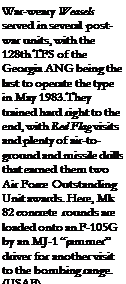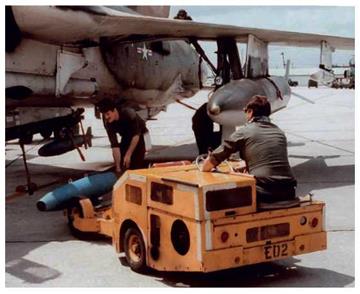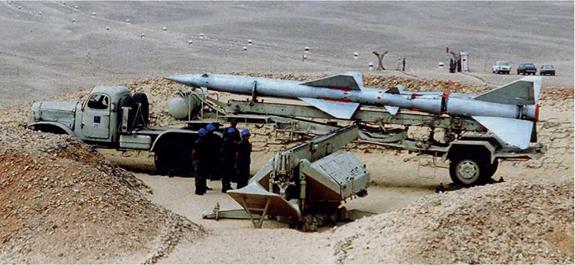AFTERMATH
 When Congress finally withdrew funding for military activity in Southeast Asia on August 15, 1973, the 12 F-105Gs of the 561st TFS Det 1 returned to George AFB, California, under Operation Coronet Bolo IV, joining the 35th TFW. The aircraft remained in service with the group until 1978, when conversion to the F-105G’s successor, the F-4G Phantom II began. After 17 Thunderchief years, the 561st TFS’s F-105Gs were passed to the Georgia Air National Guard’s 128th TFS in 1979-80. Following two years of refurbishment, the veteran aircraft flew on until May 25, 1983 when the last 128th TFS Wild Weasel (63-8299) was retired, thus ending 20 years of
When Congress finally withdrew funding for military activity in Southeast Asia on August 15, 1973, the 12 F-105Gs of the 561st TFS Det 1 returned to George AFB, California, under Operation Coronet Bolo IV, joining the 35th TFW. The aircraft remained in service with the group until 1978, when conversion to the F-105G’s successor, the F-4G Phantom II began. After 17 Thunderchief years, the 561st TFS’s F-105Gs were passed to the Georgia Air National Guard’s 128th TFS in 1979-80. Following two years of refurbishment, the veteran aircraft flew on until May 25, 1983 when the last 128th TFS Wild Weasel (63-8299) was retired, thus ending 20 years of
ANG F-105 service.
![]()
 A second unit, the 562nd TFS, was formed at George AFB with F-105Gs of the 17th WWS upon their return from Korat RTAFB in October 1974. This squadron ended the aircraft’s TAC active – duty career on July 12, 1980.
A second unit, the 562nd TFS, was formed at George AFB with F-105Gs of the 17th WWS upon their return from Korat RTAFB in October 1974. This squadron ended the aircraft’s TAC active – duty career on July 12, 1980.
The F-105G’s intended replacement, the F-4C Wild Weasel IV, which was scheduled to deploy to war in June 1966, was delayed two years by severe problems associated with the installation of the F-105’s anti-SAM equipment within the Phantom Il’s denser internal structure. Despite their lack of AGM-78 Standard ARM capability, some of the 36 modified F-4Cs operated with the 67th

TFS at Kadena AB, Okinawa, from October 1969. During Operation Linebacker II, six jets were deployed to Korat RTAFB, claiming three SAM sites and three “probables”.
Several F-4D Phantom IIs received the Bendix AN/APS-107 RHAW system and ER-142 receiver, providing crucial AGM-78 capability, but the USAF abandoned plans for 90 F-4D Wild Weasels in favor of the F-4E Advanced Wild Weasel V. With a new AN/APR-38 (later AN/APR-47) radar warning and attack system, the aircraft was able to deliver AGM-45, AGM-78, AGM-88A HARM and AGM-65 Maverick missiles. F-4Gs were among the most effective weapons during Operation Desert Storm in 1991, flying with the 561st TFS until 1996. The role then passed to the less capable, pod-equipped F-16CJ.
The SA-2 “Guideline” continued in service after the North Vietnamese invasion of South Vietnam in 1975. Although the USSR began to replace some of its 400 S-75 batteries in the late 1970s, it continued to update the missile in many modified and refurbished variants. Whereas the F-105 was only ever used by the USAF, the SA-2 became the most extensively exported system of its kind, with more than 20,000 missiles supplied to 30 users.
The SNR-75M3 “Fan Song E” was the final production variant, accompanying the SA-2E Mod 4 missile. It added two parabolic scanners above the box-like horizontal Lewis scanner housing, providing Lobe-On-Receive-Only (LORO) capability, which greatly improved the unit’s ECCM flexibility. Post-war, Vietnam continues to obtain most of its defense equipment and training from the USSR, including, in 1993, the advanced SA-10C (S300 PMU1) “Grumble” SAM.

![]() The SA-2 was an important weapon during the Middle East wars of the 1970s and the Iran-Iraq conflict in the 1980s (when it was still in production), as well as Desert Storm in 1991 — SA-2 batteries were among the 600 Iraqi missile units facing Coalition strike aircraft. Finally, it played a role in the various conflicts in the Balkans through to 1999.
The SA-2 was an important weapon during the Middle East wars of the 1970s and the Iran-Iraq conflict in the 1980s (when it was still in production), as well as Desert Storm in 1991 — SA-2 batteries were among the 600 Iraqi missile units facing Coalition strike aircraft. Finally, it played a role in the various conflicts in the Balkans through to 1999.










